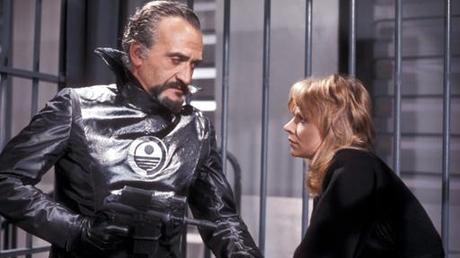Written by Malcolm Hulke
Directed by Paul Bernard
I was under the impression that “The Three Doctors” was the extent of the tenth anniversary celebration. So I was a bit surprised to learn that the producers also went for a more ambitious story arc right in the middle of the tenth season. After the minor distraction of “Carnival of Monsters”, the series launched into what is, in essence, a 12-part epic consisting of two related serials. “Frontier in Space” is the first half of the tale, and it is quite ambitious, to say the least.

The setup is simple enough. The Doctor and Jo, still fresh off the Doctor’s release from exile, end up in a period when the Earth Empire (previously mentioned in “The Mutants”) is rising, and it has come into conflict with the equally expansive Draconian Empire. With tensions running high, both sides react badly when their cargo vessels are attacked, apparently by each other. In reality, it is the Master, who is using various methods and a force of Ogrons (from “Day of the Daleks”) to destabilize the galaxy for the benefit of the Daleks.
It’s a story with enormous scale, made even better by the fact that the writers take great pains to limit perspective of the growing conflict. There are a great many complaints that the Doctor and Jo spend much of their time in one jail cell or another, but it makes sense within the context of the story, and it inevitably leads to some sort of run-in with someone who knows a piece of the puzzle. The fact that the rise of the Earth Empire is explored along the way, with the underground peace movement as counterpoint to a totalitarian government regime, is a smart layer to explore.
This was also what I would call the first true “continuity fest”. Even in the early days, the producers had a very loose interpretation of continuity, but this serial pulls in a ton of large and small references to past events on the series. The emphasis, of course, is on the Third Doctor era, but events from earlier in the series do get the occasional mention. Having run through the entire Third Doctor’s run to this point, it’s a great to see all these various ideas come together.
The liberal use of model effects is appreciated, even if they are so terribly primitive and cheap that they are worth more than a chuckle when all is said and done. But it’s clear that a lot of time and effort went into selling this brand of space opera on a “Doctor Who” budget. The sets are about as basic as one might imagine, but they serve their purpose and even work on a thematic level.
This is also the final appearance of Roger Delgado as the Master, and it’s probably one of his best uses to date. In essence, his ambition to control the universe has been harnessed by the Daleks, and he sees that as a means to his own ends. Just that hint of a motivation helps this rise above so many previous appearances, and one can only imagine where the character might have gone, had Delgado’s life not been tragically cut short.
Considering that this is the final season for Katy Manning, it’s perhaps appropriate that this is one of the best serials for the character of Jo Grant. I can’t say that she was purposefully given a growth arc over her three-season tenure, but this story gives her a more well-rounded treatment. She’s just as vapid as always, but now and then, she shows a canny intelligence. If only the character had been that way from the very beginning!
It surprised me to learn that a number of people were bored by this story. I found the opposite to be true. I started out trying to keep to an episode-by-episode schedule, but quickly found myself eager to see what happened next. That wasn’t what I had come to expect of the longer Third Doctor serials, so it was a welcome discovery.
Writing: 2/2
Acting: 2/2
Direction: 2/2
Style: 2/2
Final Rating: 8/10

